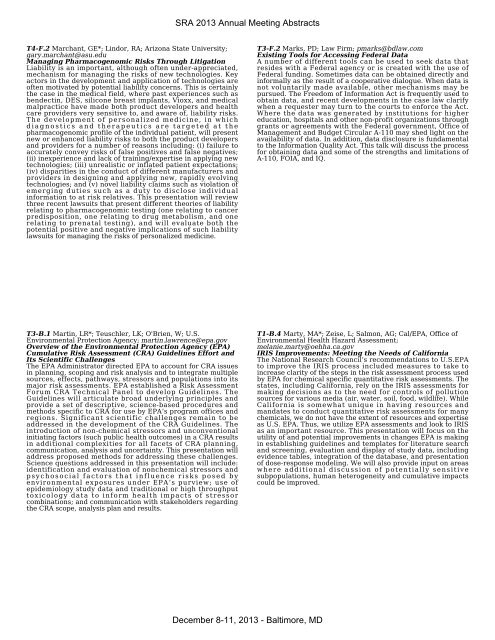Abstracts (PDF file, 1.8MB) - Society for Risk Analysis
Abstracts (PDF file, 1.8MB) - Society for Risk Analysis
Abstracts (PDF file, 1.8MB) - Society for Risk Analysis
You also want an ePaper? Increase the reach of your titles
YUMPU automatically turns print PDFs into web optimized ePapers that Google loves.
SRA 2013 Annual Meeting <strong>Abstracts</strong><br />
T4-F.2 Marchant, GE*; Lindor, RA; Arizona State University;<br />
gary.marchant@asu.edu<br />
Managing Pharmacogenomic <strong>Risk</strong>s Through Litigation<br />
Liability is an important, although often under-appreciated,<br />
mechanism <strong>for</strong> managing the risks of new technologies. Key<br />
actors in the development and application of technologies are<br />
often motivated by potential liability concerns. This is certainly<br />
the case in the medical field, where past experiences such as<br />
bendectin, DES, silicone breast implants, Vioxx, and medical<br />
malpractice have made both product developers and health<br />
care providers very sensitive to, and aware of, liability risks.<br />
The development of personalized medicine, in which<br />
diagnostics and therapeutics are targeted at the<br />
pharmacogenomic pro<strong>file</strong> of the individual patient, will present<br />
new or enhanced liability risks to both the product developers<br />
and providers <strong>for</strong> a number of reasons including: (i) failure to<br />
accurately convey risks of false positives and false negatives;<br />
(ii) inexperience and lack of training/expertise in applying new<br />
technologies; (iii) unrealistic or inflated patient expectations;<br />
(iv) disparities in the conduct of different manufacturers and<br />
providers in designing and applying new, rapidly evolving<br />
technologies; and (v) novel liability claims such as violation of<br />
emerging duties such as a duty to disclose individual<br />
in<strong>for</strong>mation to at risk relatives. This presentation will review<br />
three recent lawsuits that present different theories of liability<br />
relating to pharmacogenomic testing (one relating to cancer<br />
predisposition, one relating to drug metabolism, and one<br />
relating to prenatal testing), and will evaluate both the<br />
potential positive and negative implications of such liability<br />
lawsuits <strong>for</strong> managing the risks of personalized medicine.<br />
T3-F.2 Marks, PD; Law Firm; pmarks@bdlaw.com<br />
Existing Tools <strong>for</strong> Accessing Federal Data<br />
A number of different tools can be used to seek data that<br />
resides with a Federal agency or is created with the use of<br />
Federal funding. Sometimes data can be obtained directly and<br />
in<strong>for</strong>mally as the result of a cooperative dialogue. When data is<br />
not voluntarily made available, other mechanisms may be<br />
pursued. The Freedom of In<strong>for</strong>mation Act is frequently used to<br />
obtain data, and recent developments in the case law clarify<br />
when a requester may turn to the courts to en<strong>for</strong>ce the Act.<br />
Where the data was generated by institutions <strong>for</strong> higher<br />
education, hospitals and other non-profit organizations through<br />
grants or agreements with the Federal government, Office of<br />
Management and Budget Circular A-110 may shed light on the<br />
availability of data. In addition, data disclosure is fundamental<br />
to the In<strong>for</strong>mation Quality Act. This talk will discuss the process<br />
<strong>for</strong> obtaining data and some of the strengths and limitations of<br />
A-110, FOIA, and IQ.<br />
T3-B.1 Martin, LR*; Teuschler, LK; O'Brien, W; U.S.<br />
Environmental Protection Agency; martin.lawrence@epa.gov<br />
Overview of the Environmental Protection Agency (EPA)<br />
Cumulative <strong>Risk</strong> Assessment (CRA) Guidelines Ef<strong>for</strong>t and<br />
Its Scientific Challenges<br />
The EPA Administrator directed EPA to account <strong>for</strong> CRA issues<br />
in planning, scoping and risk analysis and to integrate multiple<br />
sources, effects, pathways, stressors and populations into its<br />
major risk assessments. EPA established a <strong>Risk</strong> Assessment<br />
Forum CRA Technical Panel to develop Guidelines. The<br />
Guidelines will articulate broad underlying principles and<br />
provide a set of descriptive, science-based procedures and<br />
methods specific to CRA <strong>for</strong> use by EPA’s program offices and<br />
regions. Significant scientific challenges remain to be<br />
addressed in the development of the CRA Guidelines. The<br />
introduction of non-chemical stressors and unconventional<br />
initiating factors (such public health outcomes) in a CRA results<br />
in additional complexities <strong>for</strong> all facets of CRA planning,<br />
communication, analysis and uncertainty. This presentation will<br />
address proposed methods <strong>for</strong> addressing these challenges.<br />
Science questions addressed in this presentation will include:<br />
identification and evaluation of nonchemical stressors and<br />
psychosocial factors that influence risks posed by<br />
environmental exposures under EPA’s purview; use of<br />
epidemiology study data and traditional or high throughput<br />
toxicology data to in<strong>for</strong>m health impacts of stressor<br />
combinations; and communication with stakeholders regarding<br />
the CRA scope, analysis plan and results.<br />
T1-B.4 Marty, MA*; Zeise, L; Salmon, AG; Cal/EPA, Office of<br />
Environmental Health Hazard Assessment;<br />
melanie.marty@oehha.ca.gov<br />
IRIS Improvements: Meeting the Needs of Cali<strong>for</strong>nia<br />
The National Research Council’s recommendations to U.S.EPA<br />
to improve the IRIS process included measures to take to<br />
increase clarity of the steps in the risk assessment process used<br />
by EPA <strong>for</strong> chemical specific quantitative risk assessments. The<br />
states, including Cali<strong>for</strong>nia, rely on the IRIS assessments <strong>for</strong><br />
making decisions as to the need <strong>for</strong> controls of pollution<br />
sources <strong>for</strong> various media (air, water, soil, food, wildlife). While<br />
Cali<strong>for</strong>nia is somewhat unique in having resources and<br />
mandates to conduct quantitative risk assessments <strong>for</strong> many<br />
chemicals, we do not have the extent of resources and expertise<br />
as U.S. EPA. Thus, we utilize EPA assessments and look to IRIS<br />
as an important resource. This presentation will focus on the<br />
utility of and potential improvements in changes EPA is making<br />
in establishing guidelines and templates <strong>for</strong> literature search<br />
and screening, evaluation and display of study data, including<br />
evidence tables, integration of the database, and presentation<br />
of dose-response modeling. We will also provide input on areas<br />
where additional discussion of potentially sensitive<br />
subpopulations, human heterogeneity and cumulative impacts<br />
could be improved.<br />
December 8-11, 2013 - Baltimore, MD
















